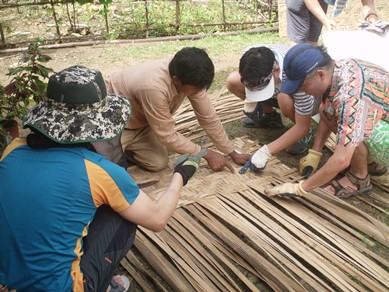Text and Photos by COOPER RESABAL
REBUILDING structures damaged by the 7.2 intensity earthquake that struck Bohol October last year not only means restoring the pre-earthquake look of the island province, but also involves harmonizing them with existing structures that reflect its colonial and non-colonial heritage.
This was the gist of the training workshop “Design and Engineering Standards for Reconstruction of Heritage Places and Earthquake-Damaged Buildings in Bohol,” conducted in the capital city of Tagbilaran July 28-August 1, 2014 by architects of the International Committee for Monuments and Sites (ICOMOS) .
Augusto Villalon, noted architect and cultural heritage planner and ICOMOS Philippine president, told participating LGU tourism officials, local architects, planners and heritage advocates, that instead of looking at damaged structures as “single independent units without any relation to the whole townscape or streetscape,” they should also see to it that “new and old structures must be seen in dialogue with each other.”
In his view, conserving heritage means “conserving all aspects: landscapes, townscapes, houses, public spaces, lifestyles, food, etc.” because the full heritage picture “represents our identity.”
Harmony can be achieved through certain height elevation of heritage and modern structures, bulk or proportion, materials and some design and color patterns.
On the question over how much restoration should be made of heritage structures, particularly the churches of Loboc, Maribojoc, and Loon, Villalon said, “Maintaining some as ruins may not be such a bad idea,” adding that many heritage ruins in Europe and Southeast Asia have become hits among tourists.
A Loboc official disclosed during the open forum that the town would most likely maintain the ruins of the Loboc church as monument to the October 15, 2013 earthquake. He said doing so will give the town an added tourism attraction.
Organizers of the training workshop which included the Bohol Tourism Office, Provincial Government, and the USAID, said aside from the training workshop lectures, they want to develop reconstruction guidelines.
Ma. Joycelyn Mananghaya, architect trustee of ICOMOS Philippines, clarified in her lecture that those involved in the rebuilding of affected places and their damaged structures must focus not only on old heritage structures.
Modern structures, she said, must be rebuilt in the same modern style, and not designed to appear like “pseudo-heritage structures.”
 “Historical honesty asks that rebuilt structures are to be redesigned in an architectural style reflective of 2014, thus becoming a visual reminder of the rebuilding of Bohol after the earthquake,” she said.
“Historical honesty asks that rebuilt structures are to be redesigned in an architectural style reflective of 2014, thus becoming a visual reminder of the rebuilding of Bohol after the earthquake,” she said.
The organizers program states “Contrary to popular belief, it is not necessary for new structures to copy or mimic heritage architecture (bagong luma style) so that the distinction between the new and the old is clear to the viewers or tourists.”
Mananghaya observed that the plaza complex gives the Bohol townscape its distinct unifying feature. It relates all the structures (of government and the church) around it, she noted.
The organizers said there’s need to study the original town plans for a possible revival. “Plazas will be restored as plazas again, where open spaces are re-landscaped, and trees along the roads are re-planted.”
“The overall look of the town will then be studied, understood, and maintained. All these are important in establishing the identity of towns, especially with the rising tourism in Bohol,” the organizers added.
Mananghaya, however, stressed the importance of making a “geologic technical study of the sub-strate” of damaged structures before making any intervention to determine the extent of structural damage.
Villalon noted that while monumental heritage, like churches, were damaged, and need restoration or repurposing, many non-monumental heritage structures were destroyed as well by the 7.2 intensity quake. However, there is little attention both from the public and government of non-monumental and private structures due to “lack of awareness of their importance.”
Monumental heritage structures or their ruins are enlivened by cultural heritage, such as lifestyle, crafts, music, dances, cuisine, farms and landscapes, etc. “We should pay attention to the entire setting,” Villalon concluded.
A field work in the towns of Loboc and Antequera gave participants the opportunity to view examples of elevations of heritage structures with adjacent modern structures (infill), and to identify the style and particular eras they were constructed.
They then presented heritage plans for Loboc, Antequera and Maribojoc towns in the form of a documentation of a townscape or a streetscape, and proposed interventions to both heritage and modern structures in sketches and drawings.
Villalon observed that Bohol is “an excellent choice to be a partner province for community-based heritage development.” Community participation, he said, makes conservation meaningful.





